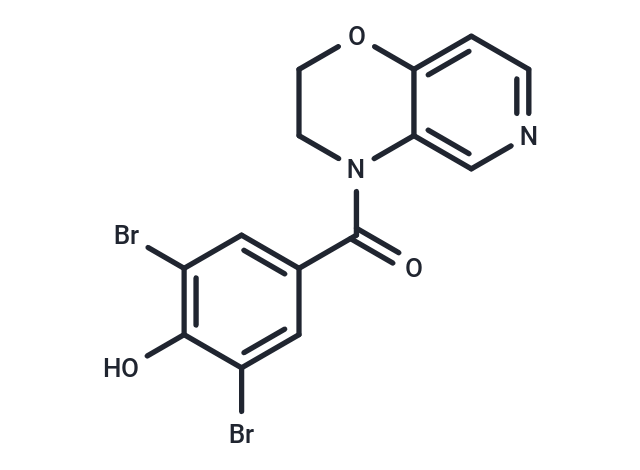Shopping Cart
- Remove All
 Your shopping cart is currently empty
Your shopping cart is currently empty

Epaminurad (UR-1102) is an orally active, potent, and selective URAT1 (urate transporter 1) inhibitor with a Ki of 0.057 μM, and it inhibits OAT1 and OAT3 (organic anion transporter) modestly. Epaminurad is a uricosuric agent used for research on gout and hyperuricemia [1].

| Pack Size | Price | Availability | Quantity |
|---|---|---|---|
| 25 mg | $1,270 | 1-2 weeks | |
| 50 mg | $1,650 | 1-2 weeks | |
| 100 mg | $2,500 | 1-2 weeks |
| Description | Epaminurad (UR-1102) is an orally active, potent, and selective URAT1 (urate transporter 1) inhibitor with a Ki of 0.057 μM, and it inhibits OAT1 and OAT3 (organic anion transporter) modestly. Epaminurad is a uricosuric agent used for research on gout and hyperuricemia [1]. |
| In vitro | UR-1102 (0-12 μM) inhibits the uptake of urate and PAH (p-aminohippuric acid) in HEK293 cells transiently expressing URAT1, OAT1, or OAT3 [1]. |
| In vivo | Administered orally once a day for three consecutive days, Epaminurad, at dosages ranging from 0-30 mg/kg, demonstrates significant uricosuric and urate-lowering effects [1]. At single dosages between 3-30 mg/kg, it also displays a favorable pharmacokinetic profile by enhancing the fractional excretion of urinary uric acid and more effectively reducing plasma uric acid levels [1]. The pharmacokinetic parameters of Epaminurad (UR-1102) in tufted capuchin monkeys include maximum plasma concentration (C max) values of 8.96 ± 1.74 μg/mL, 42.4 ± 12.8 μg/mL, and 92.9 ± 21.0 μg/mL at doses of 3 mg/kg, 10 mg/kg, and 30 mg/kg, respectively. The time to reach maximum concentration (T max) was recorded at 0.6 ± 0.2 hours, 0.5 ± 0.0 hours, and 0.8 ± 0.3 hours, respectively, with half-life (T 1/2) values of 4.7 ± 0.9 hours, 4.2 ± 1.1 hours, and 3.3 ± 0.8 hours, respectively. The area under the curve (AUC 0-inf) was 26.2 ± 8.1 mg*h/mL, 108 ± 51 mg*h/mL, and 257 ± 60 mg*h/mL for the respective doses [1]. |
| Molecular Weight | 414.05 |
| Formula | C14H10Br2N2O3 |
| Cas No. | 1198153-15-9 |
| Relative Density. | 1.887 g/cm3 (Predicted) |
| Storage | Powder: -20°C for 3 years | In solvent: -80°C for 1 year | Shipping with blue ice. |

Copyright © 2015-2025 TargetMol Chemicals Inc. All Rights Reserved.